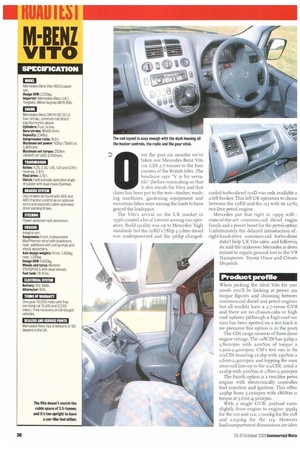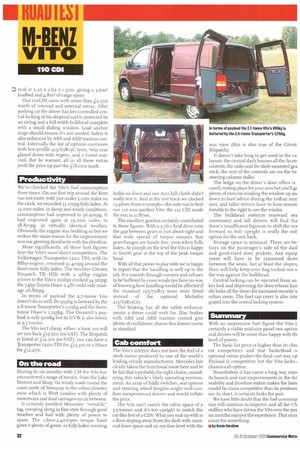ver the past six months we've taken our Mercedes-Benz Vito
Page 30

Page 32

If you've noticed an error in this article please click here to report it so we can fix it.
110 CDI 2.7-tonner to the four corners of the British Isles. The brochure says "V is for versatile" (before reminding us that it also stands for Vito) and that claim has been put to the test—timber, washing machines, gardening equipment and mountain bikes were among the loads to have graced the loadspace.
The Vito's arrival on the UK market in 1996 created a lot of interest among van operators. Build quality was up to Mercedes' high standards but the ro8D's 78hp 2.3-litre diesel was underpowered and the 961p charged cooled turbo-diesel rioD was only available a a left-hooker. This left UK operators to choos, between the r o8D and the 113 with its 127hj two-litre petrol engine.
Mercedes put that right in 1999 with state-of-the-art common-rail diesel engin, family and a power boost for the petrol option Unfortunately the delayed introduction of right-hand-drive common-rail turbo-diese didn't help UK Vito sales, and followinl its mid-life makeover Mercedes is deter mined to regain ground lost to the \AI Transporter, Toyota Hiace and Citroer Dispatch.
Product profile
When picking the ideal Vito for you needs you'll be looking at power am torque figures and choosing betweet common-rail diesel and petrol engines but all models have a 2.7-tonne GVNI and there are no chassis-cabs or high roof options (although a high-roof ver sion has been spotted on a test track sr we presume this option is in the post)
The CDI range consists of three diese engine ratings. The roSCD1 has 92hp a 3,800rpm with 2ooNm of torque a 1,500-2,400rpm; Civi's test van is till noCDI boasting ro2lip with 250Nm a I,600-2,400rpm; and topping the corn mon-rail line-up is the 112 CDI, rated a 122hp with 300Nm at 1,800-2,5oorpm The fourth option is a two-litre petro engine with electronically controller fuel injection and ignition. This offer 129hp from 5 ,roorpm with 186Nm 0 torque at 3,600-4,300rpm.
With a single GVW, payload vane: slightly from engine to engine: 995I1 for the no and riz; r000kg for the ro8 and 1,030kg for the 113. However load compartment dimensions are iden
tical at 2.30 x 1.62 x 1.37m, giving a 3.6m2 loadbed and 4.8m3 of cargo space.
Our iroCD I came with more than i2,5oo worth of internal and external extras. After parking up the driver has key-controlled central locking at his disposal and is protected by an airbag and a frill-width bulkhead complete with a small sliding window. Load anchor rings should ensure it's not needed. Safety is also enhanced by ABS and ABD traction control. Externally the list of options continues with low-profile 215/651215C tyres, twin rear glazed doors with wipers, and a tinted sunroof But be warned, all in all these extras push the price up past the Li8,000 mark.
Productivity
We've checked the Vito's fuel consumption three times. On our first trip around the Kent van test route, with just under 5,000 miles on the clock, we recorded 33.2mpg fully laden. At 12,000 miles, in damp and windy conditions, consumption had improved to 36.9mpg. It had improved again at 19,000 miles, to 38.8mpg, in virtually identical weather. Obviously the engine was bedding in but we reckon the main reason for the improvement was our growing familiarity with the driveline.
More significantly, all three fuel figures beat the Vito's most direct competitors. The Volkswagen Transporter 1200 TD1, with its 88hp engine, returned 3I.4mpg around the Kent route fully laden. The two-litre Citroen Dispatch TD HDi with a 96hp engine (closer to the Vito's io2hp) clocked 34.3mpg; the 74hp Toyota Hiace 2.4D could only manage 26.8mpg.
In terms of payload the 2.7-tonne Vito doesn't do as well. Its 995kg is bettered by the 2.8-tonne Transporter's 1,115kg and the threetonne Hiace's 1,235kg. The Dispatch's payload is only 900kg but its GVW is also lower, at 2.3 tonnes.
The Vito isn't cheap, either: a basic no will set you back L15,5oo (ex-VAT). The Dispatch is listed at £12,310 (ex-VAT); you can have a Transporter 1200 TDI for £13,301 or a Hiace for £12,270.
On the road
During its six months with CM the Vito has encountered a range of terrain, from the Lake District and Shap, via windy roads round the coast north of Newquay to the urban disaster zone which is West London with plenty of motorways and dual carriageways in between.
It certainly justified Mercedes' -versatile" tag, romping along in fine style through good weather and bad with plenty of power to spare. The 1,600-2,400rpm torque band gives it plenty of grunt, so fully laden running holds no fears and our A20 hill climb didn't really test it. And at the test track we clocked I3.46SeC from o-5omph—the only van to beat our tit) was another Vito: the 112 CDI made the run in ir.87sec.
The excellent gearbox certainly contributed to these figures. With a 3.76:1 final drive ratio the gap between gears is just about right and that wide spread of torque ensures that gearchanges are hassle free, even when fully laden. At 30mph on the level the Vito is happy in fourth gear at the top of the peak torque band.
With all that power to play with we're happy to report that the handling is well up to the job. It's smooth through corners and refuses to be buffeted by cross winds (we have no way of knowing how handling would be affected if the standard 195/7oRr5 tyres were fitted instead of the optional Michelin 215/65R15Cs).
The braking has all the safety enhancements a driver could wish for. Disc brakes with ABS and ABD traction control give plenty of confidence; shame this doesn't come as standard.
Cab comfort
The Vito's interior does not have the feel of a sleek motor produced by one of the world's leading vehicle manufacturers. Mercedes has clearly taken the functional route here and to be fair that's probably the right choice, considering this vehicle's likely operating environment. An array of fiddly switches, seat options and steering wheel heights might well confuse inexperienced drivers and would inflate the price.
The Vito can't match the cabin space of a 3.5-tonner and it's too upright to match the car-like feel of a CDV. What you end up with is a floor sloping away from the dash with minirnal knee space and an eye-line level with the sun visor (this is also true of the Citroe: Dispatch).
It doesn't take long to get used to the ca layout: the central dash houses all the heate controls, the radio and the dash-mounted gea stick; the rest of the controls are on the tw: steering column stalks.
The ledge on the driver's door offers is comfy resting place for your arm but you'll gc plenty of exercise winding the window up an down to hurl advice during the Indian sum mer, and taller drivers have to lean uncom fortably to the right to use the winder.
The bulkhead restricts rearward sea movement and tall drivers will find tha there's insufficient legroom to shift the sea forward so bolt upright is really the onl option for the seat back.
Storage space is minimal. There are twi trays on the passenger's side of the das1 and good-sized door pockets. Any equip ment will have to be crammed dow, between the seats, but at least the slopirq floor will help keep your bag tucked out o the way against the bulkhead.
Central locking can be operated from an key lock and depressing the door-release han die locks all the doors for increased security ii urban areas. The fuel cap cover is also inte grated into the central locking system.
Summary
With an impressive fuel figure the Vito i: certainly a viable mid-size panel ven option and drivers will be more than happy with thi level of power.
The basic list price is higher than its clos est competitors and that basketload o optional extras pushes the final cost way up Payload is competitive but the Vito lacks ; chassis-cab option.
Nonetheless it has come a long way sinci its launch and vast improvements in the dri veability and driveline stakes makes the bates model far more competitive than its predeces sor. In short, it certainly looks the part.
We have little doubt that the fuel consump tion will continue to improve, and all the CA staffers who have driven the Vito over the pas six months enjoyed the experience. That mus count for something.
E by Kevin Swallow












































































































































